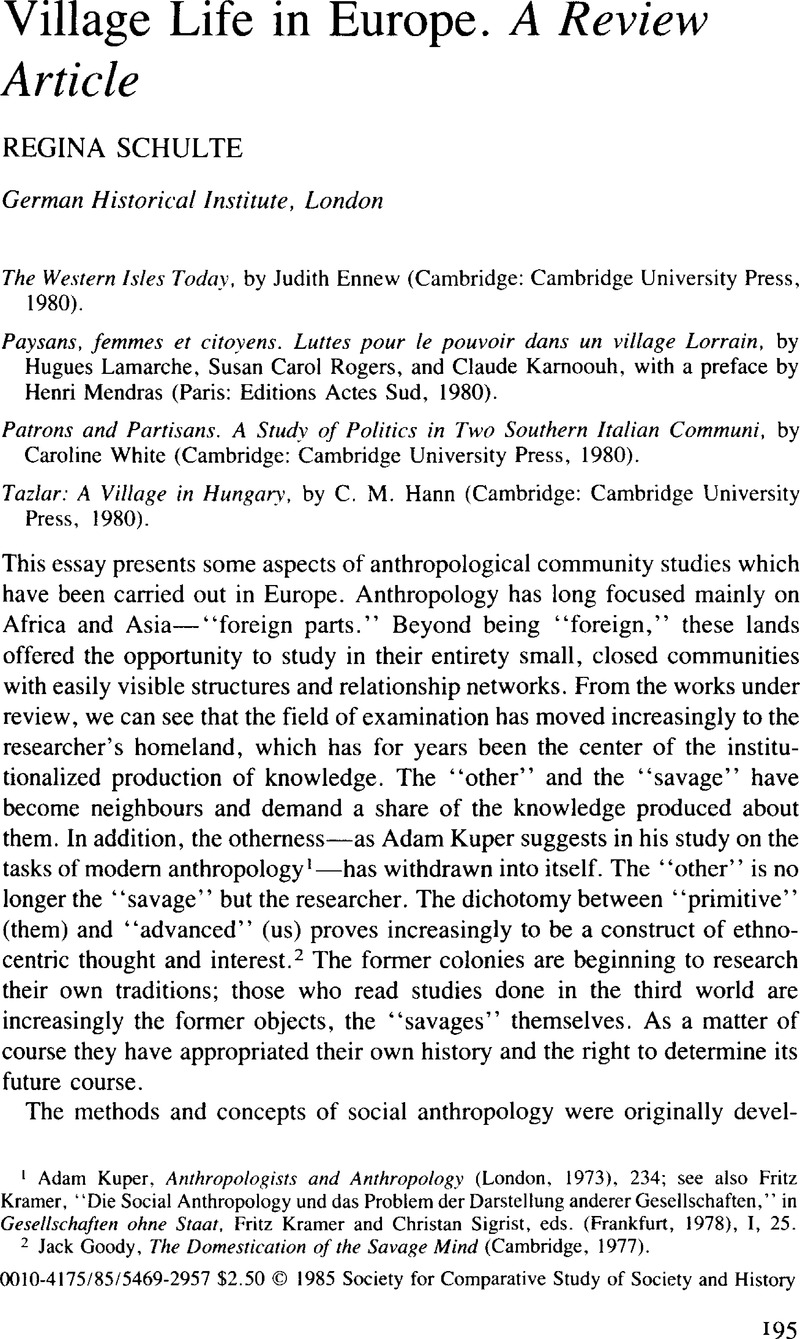No CrossRef data available.
Article contents
Village Life in Europe. A Review Article
Published online by Cambridge University Press: 03 June 2009
Abstract

- Type
- CSSH Discussion
- Information
- Copyright
- Copyright © Society for the Comparative Study of Society and History 1985
References
1 Kuper, Adam, Anthropologists and Anthropology (London, 1973), 234;Google Scholar see also Kramer, Fritz, “Die Social Anthropology und das Problem der Darstellung andererGesellschaften,” in Geseilschaften ohne Staat, Kramer, Fritz and Sigrist, Christan, eds. (Frankfurt, 1978), I, 25.Google Scholar
2 Goody, Jack, The Domestication of the Savage Mind (Cambridge, 1977).Google Scholar
3 Cf. also the studies on the village of Elmdon near Cambridge in England based on year-long cooperation between historians and anthropologists, by Robin, Jean, Elmdon: Continuity and Change in a North-West Essex Village, 1861–1964 (Cambridge, 1980);Google Scholar and Strathern, Marilyn, Kinship at the Core. An Anthropology of Elmdon, a Village in North-West Essex in the Nineteen-Sixties (Cambridge, 1981).Google Scholar
4 In the introduction to Changing Social Structures in Ghana. Essays in the Comparative Sociology of a New State and an Old Tradition, Goody, Jack, ed. and intro. (London, 1975), viii, Goody looks at the limitation of classical field work and the crisis of “empirical anthropology”: “Today even studies of rural areas have to take account of networks that stretch to and from the towns, whether these be social, economic or religious.”Google Scholar
5 Tönnies, F., Community and Association (1887; London, 1955).Google Scholar
6 Cf. also the different academic perspectives in the rich collection, The Dying Community, Gallagher, A. and Padfield, H., eds. (Albuquerque, 1980).Google Scholar
7 Cf. also on the “myth of the community,” Alan Macfarlane, in collaboration with Harrison, Sarah and Jardine, Charles, Reconstructing Historical Communities (Cambridge, 1977)Google Scholar, 1; Boissevain, J. and Friedl, J., eds., Beyond the Community: Social Process in Europe (The Hague, 1975);Google ScholarBell, C. and Newby, H., Community Studies. An Introduction to the Sociology of the Local Community (London, 1971);Google ScholarArensberg, C. and Kimball, S., Family and Community in Ireland (Cambridge, 1968);CrossRefGoogle ScholarFranklin, S. H., Rural Societies (London, 1971);CrossRefGoogle ScholarChayanov, A. V., The Theory of Peasant Economy (Homewood, III., 1966);Google ScholarPitt-Rivers, J., People of the Sierra (London, 1954).Google Scholar
8 For “the reason for high structural stability of the peasantry,” cf. Shanin, Teodor, “Nature and Logic of Peasant Economy II: Diversity and Change,” The Journal of Peasant Studies, 1 (1973), 193: “Pre-industrial society presents us with a variety of social arrangements and pro cesses which reinforce stability and cohesion by controlling the socio-economic polarisation of communities. Those arrangements also limit and reduce what has come to be called economic growth, i.e., both the rise in per capita production and the changes in the organisation of the economy which facilitate such a rise.”CrossRefGoogle Scholar
9 Cf. also Hobsbawm, Eric, “Peasants and Politics,” The Journal of Peasant Studies, 1 (1973), 7, on the question of the “peasantry as a class,” the “peasant consciousness.”CrossRefGoogle Scholar
10 Duden, Barbara and Hausen, Karin, “Gesellschaftliche Arbeit—Geschlechtsspezifische Ar-beitsteilung,” in Frauen in der Geschichte, Kuhn, Annette and Scheider, Gerhard, eds. (Dus-seldorf, 1979), 11–33Google Scholar, at 15; cf. also Rosaldo, Michelle Z., “The Use and Abuse of Anthropology: Reflections on Feminism and Cross-Cultural Understanding,” Signs. 5:3 (1980), 389–417, at 409.CrossRefGoogle Scholar
11 Cf. the pioneering work by Davis, J., People of the Mediterranean. An Essay in Comparative Social Anthropology (London, 1977).Google Scholar
12 Cf. Strathem, , Kinship at the Core, xxx: “Anthropologists' methodological rule of thumb, participant observation, plays on the extent to which the fieldworker is simultaneously insider and outsider.”Google Scholar
13 Tepichl, J., Marxisme et agriculture: le paysan polonays (Paris, 1973);Google Scholar on Poland, cf. also Galeski, B., Basic Concepts of Rural Sociology (Manchester, 1972).Google Scholar




